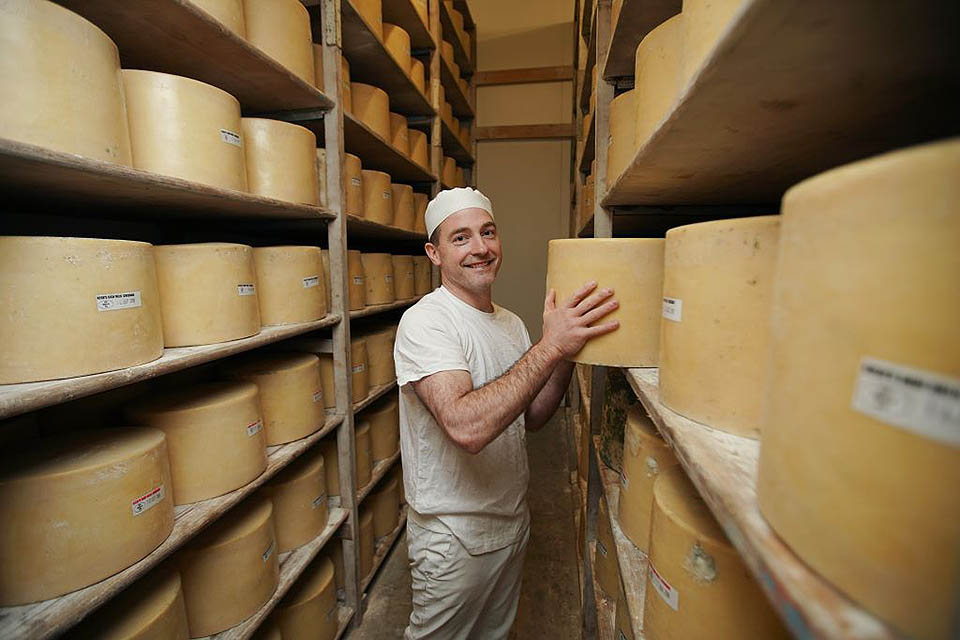
Cheddar is one of Britain’s favourite cheeses and accounts for over half the cheese sold there. In America, Cheddar is the second favourite because it’s beaten in terms of sales by mozzarella. And that’s only because of pizza. The name Cheddar has never had protected designation of origin, with the result that it’s produced all over the world especially in America and Australia. The Cheddar cheese you find in most supermarkets, unless specifically labelled could have come from anywhere and is likely to be bland bog-standard stuff that has little of the character or texture of the real thing. Despite its popularity among millions of people, I would guess that comparatively few have tasted genuine Cheddar farmhouse cheese.
Traditional Cheddar cheese comes from a village of the same name or more usually from farmhouses in the vicinity. It has been produced in the area since the 12th century. Since 2007, the registered and protected name West Country Farmhouse Cheddar indicates a cheese manufactured using traditional methods and produced from local milk sourced in Somerset, Dorset, Devon and Cornwall. My parents used to live in Somerset and Cheddar village was just a short drive down the road. It always struck me as a charmless place; a gray and dreary hamlet nestling in the foothills of Cheddar Gorge. The Gorge itself is a major tourist attraction and contains the well-known caves, formed thousands of years ago by underground rivers. In more recent times, the caves provided the ideal humidity and steady temperature for maturing the cheese which has been produced there since the twelfth century. Today though, most Cheddar cheese is matured in climate-controlled storage at the farms of origin.
Cheese of course, begins as fresh milk into which a culture is added to make the milk curdle forming curds and whey. As it gradually solidifies, the cheese is pressed into blocks. More traditionally, its pressed into barrel shapes called “truckles” and bound in cheese-cloth. As the cheese is left to mature, whether in blocks or truckles, it requires regular care including rubbing, brushing and turning over. Cheddar is usually aged from 4-6 months for a mild cheese, for 10-12 months for a sharper one and up to 24 months for a vintage Cheddar. The colour ranges from white to orange and the colour is achieved by adding annatto seed or paprika extract. Older cheeses have a distinctive nuttiness, a sharp flavour and a crumbly texture. Many Cheddar cheese companies are old family businesses. For example, the Keen family started making Cheddar in 1899 in Wincanton, a small town in South Somerset. Five generations later the company is still producing its world famous, award-winning Unpasteurized Keen’s British Cheddar Cheese.
To my mind, nothing goes better with mild Cheddar than a cold beer. The traditional drink in Cheddar country is cider, a beer-style beverage produced from the fermented juice of apples. The cheaper variety is sometimes known locally as scrumpy, a rustic brew made from lower quality fruit. The tangy fizziness of cider makes it a good partner for Cheddar though if you are having the cheese at the end of an evening meal, cider or beer are inappropriate and probably too filling.
What wine works best with Cheddar? As with most cheeses, the ideal wine pairing for Cheddar depends on its maturity. The basic rule is if the cheese is mild, select a light wine and save the more assertive wines for stronger cheeses. Young cheddar calls for a light dry white or even a sparkler. A dry sparkling Prosecco could make a good partner. Slightly older Cheddars need a fuller wine, so look for a smooth and fairly full-bodied Sauvignon Blanc from New Zealand.
Stronger Cheddars are a different matter. You need a more powerful wine to match their rich flavours. Many writers recommend Cabernet Sauvignon as a classic match for mature Cheddar for that reason. “Definitely go with a big red if you’re serving a clothbound (mature) Cheddar,” says Rachel Freier, the beverage director for Murray’s Cheese Bar in Manhattan. Full-bodied tannic reds, which can kill a Brie or Camembert stone dead, are excellent with Cheddar. The wine balances the fat and protein in the cheese, which in turn soften the tannins in the wine and accentuate the fruit. It’s probably best to go for a warm-climate Cabernet, such as those from Chile or South Australia because they are usually fruitier than their French cousins.
If you prefer white wine, you could try an oaky warm-climate Chardonnay with a mature Cheddar. This full-bodied wine with its buttery flavour pairs well with the sharpness of aged cheddar. Again, look to Chile for the richer Chardonnays. They’ll bring out the mellowness in the cheese, which in turn will enhance the fruitiness of the wine.
A classic match for English Stilton cheese is Port wine, and you could apply the same rationale to mature Cheddar especially if has become sharp and slightly pungent with pronounced nuttiness. This kind of cheese would also work with a sweetish Amontillado Sherry or a Tawny Port. As you might have guessed, in wine and cheese pairing there’s a degree of subjectivity. It’s probably best to settle on what works for you. If you have the opportunity, try some experiments!
 |
 |
 |





